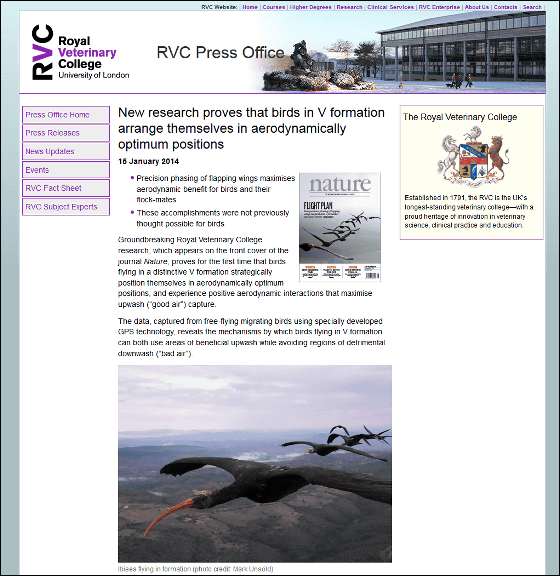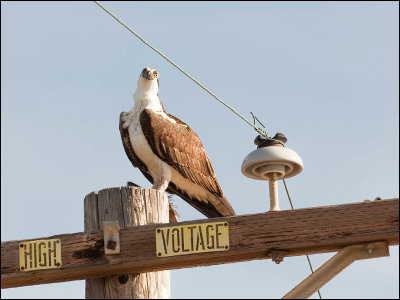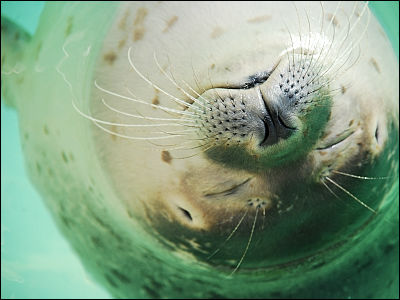What is the real mechanism by which migratory birds preserve their physical strength while maintaining "V-shaped formation"

ByTrish
When many of the birds including migratory birds fly through the sky with a flock, they may form a row in alphabetical V shape, but this is said to save energy and fly a longer distance. Why the formation of V-shaped rows can conserve energy, the unknown part remains in its detailed mechanism, but such a mystery was investigated by the research team at the University of London "together with birds" detailed investigation I succeeded in going and clarifying.
New research proves that birds in V formation arrange themselves in aerodynamically optimum positions
http://www.rvc.ac.uk/News/PressReleases/pr1401-birds-flying-in-V-formation.cfm

Why do birds fly in a V? Endangered ibis reveals its amazing secret - latimes.com
http://www.latimes.com/science/sciencenow/la-sci-sn-birds-v-formation-flight-northern-bald-ibis-nature-bioinspired-20140115,0,3808246.story#axzz2qVXaOus6
V is for vortex: Nature News & amp; Comment
http://www.nature.com/news/v-is-for-vortex-1.14507
The survey was conducted at the University of London, Royal Bethelinery College (veterinary medicine)Steven PortugalHe is Dr. Dr. has been designated as an endangered species with the cooperation of animal protection organizationsHoakaktokiGPS and accelerometer attached to the body of the body, analyzed the positional relationship in the formation during flight and vertical movement pattern caused by flapping, elucidated its mechanism.

◆ Air flow around the flapping wing
Birds push the air by moving the wings up and down, and move forward by lifting the body to the air. At this time, a flow (downward flow) pushed downward by the wing is generated in the air, and at the same time, a flow (upward flow) going upward is generated at the end of the wing opposite to the downward flow. this is"Wing tip vortex flowThe same phenomenon is occurring even on the wing of an airplane flying in the sky with the power of the air like a bird.

ByCesar harada
If we grasp the upward flow generated by this wing tip vortex well, we will generate a force to lift the body, so we need less energy to fly. This is why birds fly with V-shaped formation. Measurement with a heart rate monitor attached to a pelican crossing the Atlantic by assembling a V-shaped formation found that survey results show that heart rate is kept low in individuals flying ahead of individuals flying at the forefront , This effect is clear.

ByMichel Bakkenes
However, unlike airplanes, in the case of birds the wings are raised and lowered, so the rising flow that occurs will change (pulsate) according to the movement of the wing. In order to obtain the power of the upward flow, it is necessary to move the wing according to the movement of the pulsating air, so it was not clear why the bird can utilize its power. In order to elucidate the mystery, Dr. Portugal inspected the formation flight of Hoakaktoki in detail at the sky and analyzed in detail by using the data of the GPS sensor at the same time.

◆ Positional relationship with the preceding bird and time difference
In order to confirm the movement of the formation in detail, it is best to join the formation. Therefore, Dr. Portugal joined the organization of Hoakaktoki on a small microplane, and decided to observe the movement in real time. I recorded that movement for about 45 minutes and focused on the 7-minute data that kept V-shaped formation most stable among them.

A movie containing the appearance is released on YouTube.
NPR: The Science Of The "Flying V" Formation - YouTube
In order to take advantage of the rising flow, it is necessary to flap their wings at the timing when the pulsating upward wave of waves reaches the maximum. In other words, it is necessary to move the wing according to the wave of invisible air, but for that purpose it is necessary to accurately grasp the distance to the previous bird and the timing of flapping. Due to high precision GPS data and acceleration data obtained by Dr. Portugal's sensor attached to Hoa Kakkat, the formation always keeps an interval of about 1.2 meters and the flapping angle of the wings against the forward (and backward) Hoa Kakki I found that I kept a delay of 45 degrees on average.

Dr. Portugal says, "Hawokakutki has the ability to predict (or perceive) the upward flow caused by the front wing and its high response capability to take advantage of it, utilizing it." The flapping of birds flying at the beginning is not constant, sometimes flapping, sometimes gliding wings and gliding. The following birds have revealed that they have the ability to grasp the wave of the air at the most efficient timing and fly easily in accordance with the movement. Dr. Portugal says that this result may be applicable to flying avian bird robots.

Related Posts:







